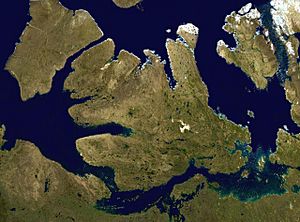Victoria Strait facts for kids

The Victoria Strait is a waterway in northern Canada. It is located in Nunavut, a territory in the Canadian Arctic. This strait is part of the Arctic Ocean. It lies between two large islands: Victoria Island to the west and King William Island to the east.
From its northern end, Victoria Strait connects to the M'Clintock Channel and the Larsen Sound. To the south, it opens into the Queen Maud Gulf. The strait is about 160 kilometers (100 miles) long. It is also quite wide, ranging from 80 to 130 kilometers (50 to 80 miles) across.
Contents
What is Victoria Strait Like?
Victoria Strait is generally wide and does not have many islands. One notable exception is the rather large Royal Geographical Society Island. This island is located near the Queen Maud Gulf, at the very southern part of the strait.
Water Depth and Ice
The strait has not been fully mapped in detail. However, parts that have been surveyed show some areas where the water is only about 9 meters (30 feet) deep. Even though ships drawing up to 9 meters (30 feet) of water have sailed through, it is very challenging because of the ice.
Most of the year, Victoria Strait is covered with thick, rough ice. A lot of this ice is polar ice. It flows down from the Viscount Melville Sound through the M'Clintock Channel. The ice in the strait usually starts to break up in late July. This continues until late September, when the water begins to freeze again.
History and Exploration
Victoria Strait holds an important place in Arctic exploration history. It was near the entrance of this strait that two famous ships, HMS Terror and HMS Erebus, became stuck in the ice. This happened during John Franklin's expedition in 1848. The ships were later abandoned.
Because of how dangerous the strait was, explorers often used a longer route. This route went around King William Island. Even though this path had shallower waters, it was considered easier to navigate than Victoria Strait.
Modern Icebreaker Journeys
The Victoria Strait was first used by an icebreaker in 1967. This powerful ship was the CCGS John A. Macdonald. It traveled through the strait to help other ships in the western Arctic. The same icebreaker crossed the strait again in 1975. Later, in 1976, two more icebreakers, the CCGS Louis S. St-Laurent and the CCGS J.E. Bernier, also sailed through Victoria Strait.
See also
 In Spanish: Estrecho Victoria para niños
In Spanish: Estrecho Victoria para niños

